Abstract
Climate change adaptation in ecologically sensitive agriculture remains underexplored, especially regarding whether farmers’ climate perceptions translate into ecological production behaviors (EPBs). Using survey data from 730 tea farmers in China’s Wuyi Mountains National Park, this study examines how general and extreme climate change perceptions relate to EPB adoption. Employing Ordered Probit models and Karlson-Holm-Breen (KHB) mediation analysis, we estimate perception–behavior associations and test indirect effects through information-seeking and policy participation, alongside moderation by ecosystem service cognition and ecological production benefit cognition. The results indicate that both general and extreme climate perceptions are positively associated with EPB adoption (β = 0.406 and 0.626, p < 0.01), with extreme perceptions showing significantly stronger effects. Climate perceptions influence EPB adoption across all dimensions (green production, ecological management, and market-based practices). Information-seeking and policy participation function as complementary mediating pathways (combined indirect effects = 0.101 and 0.117), linking climate perceptions to ecological actions. Moreover, higher ecosystem service cognition and ecological production benefit cognition strengthen the perception–behavior relationships across multiple EPB dimensions. Overall, the findings suggest that climate change perceptions are an important driver of farmers’ ecological production choices in high-ecological-value contexts. Interpreted alongside existing adaptation strategies, EPB may enhance resilience by leveraging ecosystem functions while aligning with market incentives for ecological products. These results underscore the value of policies that improve access to ecological training and market information and support demonstration programs that facilitate experiential learning.
1. Introduction
Climate change poses significant challenges to global agricultural production, fundamentally altering temperature patterns, precipitation regimes, and extreme weather frequency [,]. Farmers respond to these climate pressures through a variety of adaptation strategies, including adjustments in crop choice, land and water management, farming systems, input use, and institutional or knowledge-based practices [,,]. In terms of factor inputs, research on major grain crops such as wheat, maize, and rice shows that pesticide and fertilizer applications often exhibit increasing trends as many farmers seek to maintain yields under climate stress through intensified chemical inputs [,,,]. However, for ecologically sensitive crops in high ecological value regions, this input-intensification approach may be counterproductive [,]. Unlike scale-intensive commodity crops that can buffer climate risks through technological solutions, quality-dependent crops rely fundamentally on environmental conditions and ecosystem stability, making increased chemical applications potentially detrimental to both product quality and long-term sustainability [,].
Nature-based solutions (NbSs) have emerged as promising alternatives for climate adaptation that work with rather than against ecological systems [,]. At the farm level, ecological production behavior (EPB) represents a key pathway for implementing NbS. EPB refers to the production practices adopted by farmers to reduce agricultural pollution, save resources and protect the ecological environment []. The scope of EPB has been gradually expanding. It is no longer limited to on-farm cultivation practices but increasingly extends along the agricultural value chain and is closely integrated with market value realization, which is becoming an important strategy for smallholder farmers to address both climate risks and market challenges []. Growing evidence suggests that EPB can provide multiple benefits, including enhanced soil health, biodiversity conservation, improved product quality, and access to premium markets through certification schemes []. However, the mechanisms through which farmers adopt EPB in response to climate risks, particularly in ecologically sensitive agricultural systems, have not received sufficient attention.
Existing research on EPB adoption has identified various driving factors across different categories. Individual and household characteristics such as age, education, and income levels influence farmers’ capacity and willingness to adopt ecological practices []. Policy factors, including subsidies, regulations, and extension services, create institutional incentives and constraints for ecological production []. Market factors, particularly perceived economic benefits and certification premiums, serve as key motivations for EPB adoption []. Additionally, cognitive factors such as environmental awareness and ecosystem service recognition shape farmers’ attitudes toward ecological practices []. However, regarding climate change adaptation specifically, the causal relationship between climate change perceptions and ecological production behavior remains unclear, particularly for ecologically vulnerable crops in high ecological value regions. While extensive research documents input-intensification responses to climate risks among commodity crops, whether and how farmers of sensitive crops translate climate concerns into ecological behaviors presents a theoretically and empirically interesting question []. For scale-intensive, factor-intensive agricultural systems, ecological production behaviors may offer limited climate benefits or even create trade-offs with productivity. But for high ecological value regions producing sensitive crops, this causal relationship may operate differently, warranting systematic investigation. Moreover, while existing studies have separately considered the roles of cognitive mechanisms and economic factors in how climate perceptions influence farmers’ adaptive behaviors, few have simultaneously analyzed how climate perceptions, cognitive mechanisms, and economic factors jointly shape farmers’ ecological production behaviors [,].
This study examines these dynamics through tea production in China’s Wuyi Mountains National Park region. National parks represent archetypal high ecological value areas where ecosystem services are most intact, while tea exemplifies ecologically sensitive crops whose quality depends critically on environmental conditions []. In this region, tea serves as the primary livelihood source for smallholder farmers, with unit values far exceeding those of staple crops, making farmers particularly attentive to climate change impacts that could threaten both production stability and quality premiums. This setting offers a representative case for examining climate-driven ecological adaptation in high-value agricultural systems.
The research makes three key contributions. First, we establish causal relationships between climate change perceptions and EPB adoption among sensitive crops in high ecological value regions, filling a critical gap in climate adaptation research. Second, we reveal the intrinsic motivations and behavioral logic underlying farmers’ EPB adoption, providing insights into decision-making processes that differ from conventional adaptation strategies. Third, we demonstrate that ecological value marketization through EPB represents an important NbS practice for climate adaptation, bridging conservation and climate objectives through market mechanisms.
2. Theoretical Framework and Research Hypotheses
This study applies Protection Motivation Theory (PMT) to explain how climate change perceptions drive the adoption of ecological production behavior (EPB) among tea farmers in high-ecological-value regions. PMT proposes that protective actions arise from two cognitive processes: threat appraisal and coping appraisal [,]. Threat appraisal involves assessing the severity of a risk and one’s vulnerability to it, while coping appraisal evaluates both the effectiveness of a protective response (response efficacy) and the ability to perform it (self-efficacy). When both appraisals are strong, protective motivation emerges. This framework helps clarify why awareness of climate change sometimes leads to ecological adaptation but often stops at concern.
In agriculture, climate risk perceptions function as threat appraisals that initiate adaptive motivation. Two forms of perception represent distinct dimensions of this process. General climate change perception (SCP) captures awareness of long-term shifts—gradual warming, irregular rainfall, and ecosystem degradation—that threaten the environmental stability of production. A higher SCP encourages strategic, preventive adaptation. Extreme climate change perception (ECP) reflects recognition of acute climatic shocks such as floods or droughts that disrupt yield and quality. Farmers with stronger ECP tend to prioritize immediate resilience and risk control.
For tea farmers, these threat appraisals are particularly intense. Tea quality depends on subtle ecological balances, and fluctuations in temperature or humidity directly affect biochemical composition and market value. Unlike grain crops, yield protection through chemical intensification cannot offset these losses. Production within a protected area further reinforces this vulnerability, as ecosystem integrity is not only a biophysical condition but also a legal and reputational constraint. The result is a heightened sense of threat that stimulates motivation toward ecological management.
Whether this motivation transforms into real behavioral change depends on coping appraisal. Farmers must believe that EPB can effectively mitigate risks (response efficacy) and that they are capable of implementing it (self-efficacy). The development of self-efficacy is strongly shaped by information-seeking behavior (ISB) and policy participation behavior (PPB), which act as key mediating mechanisms. Through ISB—consulting extension officers, learning from peers, or tracking climate information—farmers gather evidence that ecological management works in practice. Exposure to successful cases and technical knowledge reduces uncertainty and builds confidence in personal ability. PPB complements this by providing structured opportunities for action. Participation in training programs, cooperatives, or agri-environmental schemes offers hands-on experience, subsidies, and institutional guidance that lower adoption barriers. Both ISB and PPB convert general motivation into self-efficacy by turning climate concern into practiced capability.
At the same time, farmers differ in how they judge the effectiveness of ecological production, reflecting variation in response efficacy. Two forms of cognition—ecosystem service cognition (ESSC) and ecological production benefit cognition (EPC)—serve as crucial moderators in this appraisal. ESSC reflects an understanding of how ecological functions such as soil fertility, pollination, and microclimate stability sustain production. Farmers with high ESSC see EPB as a direct and reliable means of protecting yields and quality. EPC captures recognition of the economic and practical advantages of ecological production. Farmers who connect ecological management with market premiums, cost savings, or long-term stability perceive it as both feasible and rewarding. Together, ESSC and EPC strengthen confidence that ecological behavior is not only environmentally effective but also beneficial in practice.
In summary, we have established a theoretical analysis framework for the impact of farmers’ climate change perception on EPB adoption behavior, as shown in Figure 1.
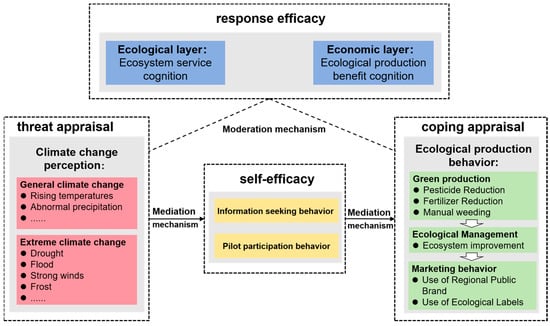
Figure 1.
Theoretical analysis framework.
The specific hypotheses derived from this framework, along with their theoretical basis, variables, and expected directions, are summarized in Table 1.

Table 1.
Summary of hypotheses based on the PMT framework.
3. Materials and Methods
3.1. Study Area
This study focuses on the Wuyi Mountain region in southeastern China, a UNESCO World Heritage site and one of the most important ecological tea-producing areas in East Asia. The region is dominated by smallholder agriculture with fragmented landholdings, labor-intensive cultivation, and strong dependence on tea income. Its recent designation as a national park has brought increasing emphasis on ecological conservation and sustainable land management, making it an ideal setting for examining climate–agriculture interactions in high-ecological-value landscapes.
Wuyi Mountain has a humid subtropical monsoon climate, with a mean annual temperature of about 19 °C and annual precipitation near 1900 mm—substantially higher than the national averages of 10.7 °C and 645 mm. Frost-free days exceed 330 per year, compared with roughly 250 days nationally, indicating a mild and moist environment favorable for perennial crops. The complex terrain and extensive forest cover generate diverse and stable microclimates, which contribute to the region’s ecological sensitivity and its long-standing reputation for producing premium oolong tea.
Tea grown in the area is Camellia sinensis, a species that requires warm temperatures (18–25 °C), abundant rainfall (>1200 mm), high humidity, and diffuse light. Its leaf quality and biochemical composition respond strongly to microclimatic variation, soil organic matter, and canopy conditions. The ecological characteristics of Wuyi Mountain closely match these requirements, while also amplifying the crop’s sensitivity to environmental change.
Meteorological records from 1990 to 2024 indicate clear signals of climate change in the region (Figure 2 and Figure 3). Mean annual temperatures have risen by 1.6 °C, and the number of extreme heat days (>35 °C) has increased from fewer than 20 per year in the 1990s to more than 70 in recent years. Precipitation has become more variable, with frequent extreme rainfall events. These documented gradual and extreme changes directly affect tea growth, quality formation, and farmers’ production decisions.
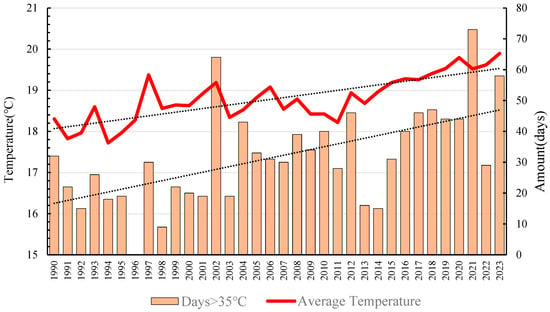
Figure 2.
Changing trends of average temperature and number of extremely high temperature days in Wuyi Mountain (1990–2024). The dashed lines show the projected future trend based on current data.

Figure 3.
Changing trends of extreme precipitation days and annual rainfall imbalance index in Wuyi Mountain (1990–2024). heavy_p95 represents the number of days with daily precipitation exceeding the 95th percentile threshold, while cv_rain denotes the coefficient of variation of annual daily rainfall. Both indicators are calculated based on daily temperature and precipitation records from the Wuyishan Meteorological Station. The dashed lines show the projected future trend based on current data.
Taken together, the Wuyi Mountain region provides a representative case for understanding how climate variability interacts with ecologically sensitive, high-value agricultural systems. Its ecological fragility and economic reliance on tea make it a pertinent context for examining farmers’ climate perceptions and their adoption of ecological production behaviors.
3.2. Data Sources
Data were collected between June 2023 and July 2024 through a structured household survey. To ensure instrument validity, the questionnaire was pilot-tested with 30 tea farmers in a non-sampled village, and revisions were made to improve wording clarity, scale consistency, and item ordering. Enumerators received standardized training on interview procedures, question explanation, and field ethics to minimize interviewer bias and enhance response reliability.
Sampling followed a three-stage stratified random design aimed at capturing ecological and production heterogeneity within the Wuyi Mountain National Park region. In the first stage, four townships were selected based on three criteria: (1) tea production intensity, (2) ecological relevance to the national park landscape, and (3) administrative coverage within or adjacent to park management zones. In the second stage, 5–8 villages per township were randomly drawn from the official village registry. In the third stage, 20–30 tea-farming households per village were randomly sampled for face-to-face interviews, yielding 730 valid observations (see in Figure 4).
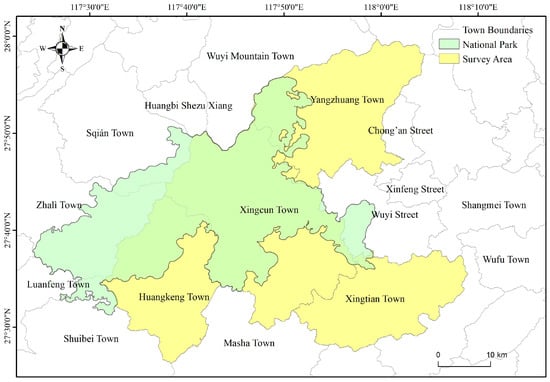
Figure 4.
Map of the study area in Wuyi Mountain.
Our final sample of 730 cases exceeds sample-size recommendations for mediation and moderation models [,], thereby providing adequate statistical power. Although per-village sample sizes are modest, pooling observations across stratification layers reduces normality concerns and preserves sufficient variance for regression-based inference.
3.3. Variable Definition
Dependent Variable: EPB. Considering the expansion of the connotation of ecological production behavior and the practice in the Wuyi Mountain area, this paper defines ecological production behavior to include three aspects: green production, ecological management, and ecological labeling, which reflects the ecological transformation path of the entire process of tea production. The specific classification and adoption of ecological production behavior are shown in Appendix A, Table A1.
Explanatory Variables: SCP and ECP. In the questionnaire, we measure general climate change perception and extreme climate change perception by asking respondents, “Do you think the temperature and rainfall have changed significantly in the past 5 years?” and “Do you think extreme weather events have increased in the past 5 years?”, respectively. We use a Likert scale ranging from 1 to 5 for measurement. The measured climate change perceptions correspond to documented local climate trends described in Section 3.1.
Moderating Variables: ESSC and EPC. The measurement of farmers’ cognition of ecosystem functions is based on the Millennium Ecosystem Assessment framework []. In the questionnaire, we designed four questions from the perspectives of provisioning services, regulating services, supporting services, and cultural services, which have been widely applied in agricultural perception studies []. According to FAO’s framework on nature-based solutions in agriculture [], cognition of ecological production benefits is measured from three aspects: tea premium, quality improvement, and operational sustainability. All questions are measured using a Likert scale ranging from 1 to 5 to reflect the degree of agreement. Both ESSC and EPC are computed as equal-weighted averages because the items represent complementary formative components rather than reflective indicators of a single latent trait, consistent with established formative-index practice [,]. The specific content of the questions is shown in Appendix A, Table A2.
Control Variables. In addition to the core explanatory variables in this study, farmers’ ecological production behaviors may also be influenced by a multitude of other factors. Based on existing research [,,], this study categorizes control variables into three groups: household head, family, and environmental characteristics. The specific content is shown in Table 2.

Table 2.
Descriptive statistics of variables.
3.4. Model Construction
Given EPB’s ordinal nature ranging from low to high ecological adoption, we use an Ordered Probit model to estimate farmers’ ecological behavior choices, and this specification is more suitable than Ordered Logit or SEM, given the normality assumption of the latent propensity and the use of single-item or formative indicators in our measurement framework. The model is established as follows:
In Equation (1), represents the degree of adoption of ecological production behaviors by farmers, and represent the farmers’ perceptions of general climate change and extreme climate change, respectively. represents a set of control variables, is the constant term, , , and are the coefficients to be estimated for the explanatory variables, and is the random disturbance term, reflecting the impact of unobservable factors on farmers’ ecological production behaviors. Assuming , the model can be expressed as:
In Equation (2), are the threshold parameters to be estimated, and the values of range from 0 to 6, representing the probabilities of farmers adopting 0, 1, 2, 3, 4, 5, or 6 types of ecological production behaviors, respectively. By constructing the likelihood function, the model parameters are estimated using the maximum likelihood method.
To further examine the mechanisms through which climate change perceptions affect farmers’ ecological production behaviors, we employ the Karlson–Holm–Breen (KHB) method to conduct mediation analysis within the non-linear Oprobit framework. The KHB approach is particularly suitable because it (i) allows decomposition of total effects into direct and indirect components in both linear and non-linear probability models, (ii) eliminates the rescaling bias inherent in non-linear estimators, and (iii) permits comparison of mediation effects across multiple mediators.
Let and denote the two mediating variables (information-seeking and pilot-participation behaviors). The baseline model with mediators can be
where and are the coefficients of climate change perceptions after controlling for mediators, and , capture the effects of the mediators.
The total effect (TE) of, e.g., SCP, can thus be decomposed into:
where is the direct effect of climate change perceptions on ecological production behavior net of the mediators, and represents the indirect effects transmitted through information-seeking () and pilot-participation (). The KHB method ensures that the difference is an unbiased estimate of the combined indirect effect, avoiding the rescaling bias problem that typically arises in non-linear models.
4. Results
4.1. Baseline Regression
We estimated the impact of climate change perceptions on ecological production behavior adoption using ordered Probit models, with results shown in Table 3. Diagnostic tests also indicate no substantive multicollinearity (mean VIF = 1.16), supporting the stability of the estimated coefficients. The proportionality test indicates no significant violation of the parallel regression assumption, supporting the suitability of the Ordered Probit specification. Model (1) examined the effect of general climate change perception (SCP), which positively influenced EPB adoption at the 1% significance level. Model (2) analyzed extreme climate change perception (ECP), which also positively influenced EPB at the 1% significance level. Model (3) included both perception types simultaneously, with both SCP and ECP remaining significant at the 1% level, confirming the robustness of these relationships. Models (4)–(6) examined EPB dimensions separately. For green production (GP), both SCP and ECP showed significant positive effects at the 1% level. For ecological management (ET), SCP and ECP were similarly significant. For market-based practices (MB), SCP and ECP maintained strong positive effects, indicating that climate perceptions influence all EPB dimensions.

Table 3.
Baseline regression results.
Control variables revealed important patterns. Tea income dependency (ITI) consistently promoted EPB adoption in Models (1)–(4), with coefficients significant at the 1% level. This suggests that farmers more dependent on tea income are more motivated to adopt ecological practices for quality protection. National park location (NP) consistently exerts a positive and significant influence on overall EPB in Models (1)–(3), and shows a positive effect on market-based practices in Model (6). This indicates that the institutional and market environments associated with the national park support the adoption of ecological upgrading strategies. Tea land type (TLT) showed consistently negative effects, suggesting that farmers with hillside tea gardens are more likely to adopt ecological practices compared to those with plain land, possibly due to greater environmental sensitivity and quality premiums associated with mountain tea production.
Age of household head (AHH) negatively influenced EPB adoption across all models, while education level (EHH) showed positive effects, indicating that younger, more educated farmers are more likely to adopt ecological practices in response to climate concerns. The number of family laborers (LNH) positively affected EPB, reflecting the labor-intensive nature of ecological production methods.
Overall, both general and extreme climate change perceptions significantly promote farmers’ ecological production behavior adoption, with extreme perceptions showing stronger effects. The relationships hold across all EPB dimensions, suggesting that climate concerns drive comprehensive ecological transformation rather than selective practice adoption. Farmers more dependent on tea income, those in national parks, and those with hillside tea gardens show greater responsiveness to climate perceptions in adopting ecological practices.
4.2. Endogeneity Test
To address potential endogeneity arising from reverse causality and measurement errors, we adopt an instrumental variable strategy within the CMP framework. For general climate change perception (SCP), we use the altitude of farmers’ residences (HEI) as the instrument, since high-altitude areas are more sensitive to long-term climate trends and fluctuations [,]. For extreme climate change perception (ECP), we use whether farmers purchase tea tree insurance (INS) as the instrument, as insurance uptake reflects attention to climate-related risks but has no direct effect on ecological production behaviors [,]. Both instruments are theoretically exogenous to farmers’ ecological decisions.
Following Zhu et al. and Chang et al. [,], the CMP method is implemented in two stages: the first stage estimates the endogenous variables using the instruments and controls, and the second stage substitutes the fitted values into the benchmark model. Results (Table 4) show that HEI significantly predicts SCP and INS significantly predicts ECP, confirming instrument relevance. The CMP estimates indicate that after controlling for endogeneity, both SCP and ECP remain significantly positive determinants of ecological production behavior, consistent with the baseline regression. The error correlation term atanhrho 12 is significant at the 5% level, supporting the presence of endogeneity and the necessity of IV estimation.

Table 4.
Endogeneity test results.
In terms of identification diagnostics, the Kleibergen–Paap rk LM statistics reject the null of under-identification. Weak instrument tests are also passed: the Cragg–Donald Wald F statistics are above the Stock–Yogo critical value of 16.38 (10% maximal IV size), confirming that instrument strength is not a concern. Overall, these results indicate that our income is robust to endogeneity bias.
4.3. Robustness Checks
Robustness checks were conducted using Poisson regression, a 5% truncated model, and variable substitution approaches (see in Table 5). First, Models (1) and (2) report the regression results under the Poisson regression and 5% truncated model. In both models, SCP and ECP show significant positive effects on farmers’ ecological production behavior. Models (3) and (4) replace the original climate perception variables with alternative measures. SCP is replaced by farmers’ perceptions of temperature and rainfall changes over the past five years (TEM5 and RAI5), while ECP is replaced by the number of extreme weather events experienced in the past five years (EWE), including droughts, floods, frosts, and windstorms. In both models, the substituted variables continue to exert significant and positive effects on farmers’ ecological production behavior. These results further confirm the robustness of the relationship between climate change perception and ecological behavior, indicating that farmers’ actual climate experiences and perceived climate changes play an important role in shaping their ecological responses. Model (5) incorporates all of the above alternative variables simultaneously. The coefficients for the changed SCP and ECP variables remain positive and significant, further demonstrating the robustness of the findings.

Table 5.
Robustness test results.
4.4. Mechanism Analysis
To examine the pathways through which climate change perceptions influence EPB adoption, we employ the KHB method to decompose total effects into direct and indirect components. We test two mediating mechanisms: information-seeking behavior (ISB) and policy participation behavior (PPB).
Table 6 presents the mediation analysis results. Both information-seeking and policy participation serve as significant mediating pathways for the climate perception-EPB relationship. The indirect effects are significant across all specifications, supporting hypotheses H2a and H2b. Notably, when both mediators are included simultaneously, the combined indirect effects increase substantially (from 0.079 to 0.101 for SCP, and from 0.075 to 0.117 for ECP), indicating complementary mediation effects between the two pathways.

Table 6.
The result of mechanism analysis.
The results show that both SCP and ECP not only exert direct influences on ecological production behavior but also operate indirectly through these two channels. Information-seeking behavior reflects farmers’ willingness to actively acquire and update knowledge about climate change and ecological practices. This process strengthens their ability to translate abstract climate perceptions into concrete ecological decisions. Pilot participation behavior, in contrast, captures farmers’ institutional engagement, providing them with access to policy incentives, technical training, and demonstration effects that further encourage ecological adoption.
4.5. Moderating Effect Analysis
We examine how cognitive factors moderate farmers’ responses to climate change perceptions by testing ecological production cognition (EPC) and ecosystem service cognition (ESSC). Variables are mean-centered to reduce multicollinearity.
Table 7 reports the moderating effects. Models (1) and (2) show significant positive interactions for SCP × EPC and ECP × EPC (0.228 and 0.241, respectively, both p < 0.01), indicating that farmers with stronger production benefit awareness exhibit heightened responses to climate perceptions. Models (3) and (4) demonstrate similar patterns for ESSC interactions (0.193 and 0.246, both p < 0.01), showing that ecosystem service understanding amplifies climate-driven behavioral changes.

Table 7.
Moderating Effects Analysis results.
These patterns reflect the dual pathways through which EPB builds climate resilience. ESSC enhances farmers’ recognition of biophysical benefits from ecological practices. Farmers with stronger ecosystem awareness better understand how these practices improve soil health, conserve biodiversity, and regulate microclimates. EPC operates through economic channels by strengthening farmers’ appreciation of market premiums and financial returns from ecological production. This provides economic buffers against climate shocks and enables adaptation investments.
Both cognitive factors consistently amplify responses across general and extreme climate perceptions. This demonstrates that ecological knowledge and economic expectations enable farmers to translate environmental awareness into adaptive behavior. The moderating effects operate through distinct but complementary mechanisms: ecosystem function enhancement for biophysical resilience and value realization for economic resilience. To visualize the moderation effects, we plot the marginal effects of SCP and ECP on EPB across different levels of ESSC and EPC (see Appendix A Figure A1, Figure A2, Figure A3 and Figure A4).
5. Discussion
5.1. Climate Perceptions and Behavioral Responses
Our results show that both general and extreme climate change perceptions significantly promote EPB adoption, with extreme perceptions exerting stronger effects. This pattern is consistent with recent empirical findings that heightened awareness of acute climatic shocks increases farmers’ motivation to adopt adaptive or ecological practices [,]. These studies similarly emphasize that climate perception acts as an endogenous behavioral driver rather than a passive response to policy. Farmers in regions such as the Mediterranean area of Spain [], Mauritius [], Ghana [], and Kenya [] also view ecological production behaviors as climate adaptation actions, which is consistent with our research.
The mediating roles of information-seeking and policy participation are also aligned with recent evidence. Byfuglien et al. [] information is framed strongly shapes behavioral responses, while Ewulo et al. [] show that access to advisory services and institutional programs jointly facilitates climate-smart practice adoption. These findings support our argument that cognitive updating and experiential learning are both necessary for translating perception into ecological action.
The moderating effects of ecosystem service cognition and ecological production benefit cognition likewise echo recent psychological and behavioral studies. Purwanti et al. [] find that perceived response efficacy and ecological understanding significantly strengthen adaptation intentions, while Ewulo et al. [] report that expected economic benefits increase the likelihood of adopting ecological or climate-smart practices. This reinforces our conclusion that both biophysical and economic cognitions enhance farmers’ capacity to recognize EPB as a rational climate adaptation strategy.
Overall, integrating these recent studies indicates that the mechanisms observed in the Wuyi Mountain region reflect a broader global pattern: climate risk perception promotes ecological behavior when farmers have adequate information support, institutional engagement, and ecological-economic cognition.
5.2. Mechanisms of EPB Adaptation to Climate Change
Ecological production behavior shows a dual role logic in the process of adapting to climate change in the Wuyi Mountains (Figure 5). This model demonstrates how EPB enables simultaneous enhancement of biophysical resilience and economic returns under climate uncertainty, explaining why climate perceptions drive ecological rather than conventional adaptation responses in our study context.
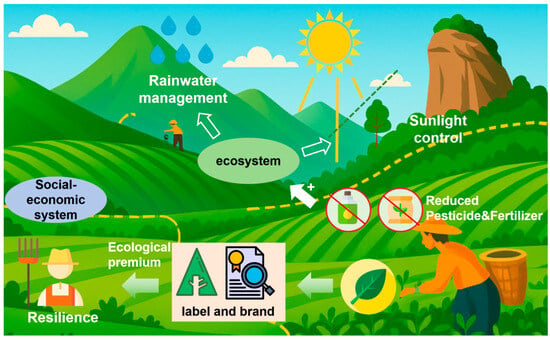
Figure 5.
The dual-pathway climate adaptation of EPB.
The ecosystem function enhancement pathway operates through EPB practices that strengthen natural climate buffering. Reducing chemical inputs preserves soil microbial communities essential for nutrient cycling and water retention. Biodiversity conservation maintains natural pest control that becomes more valuable under climate stress. Ecological management creates microclimate regulation that stabilizes growing conditions. These ecosystem services function as biological infrastructure providing climate resilience unavailable through technological solutions alone []. The economic value realization pathway operates through market mechanisms rewarding ecological production. EPB enables access to certification schemes, geographical indications, and national park branding that create price premiums—approximately 10% higher per kilogram for ecological tea in Wuyi Mountains []. These premiums provide economic buffers against climate-induced production variability while incentivizing continued ecological practices. The convergence of biophysical and economic benefits creates positive feedback where climate adaptation becomes economically self-reinforcing.
EPB provides a dual pathway for climate adaptation by enhancing ecosystem functions and enabling farmers to capture ecological value through certification, branding, and premium markets. These mechanisms help explain why climate perceptions can translate into ecological rather than conventional responses. However, the institutional and informational processes that enable EPB—such as information-seeking, technical training, and certification compliance—are not cost-free. Farmers often face time constraints, learning burdens, and financial or administrative costs, particularly when engaging with new production standards or institutional programs. These frictions may limit adoption for smallholders despite the long-term ecological and economic gains associated with EPB. Recognizing both the benefits and the practical barriers is therefore essential: only when supportive policies reduce transaction costs, provide targeted training, and streamline access to certification and market channels can the net advantages of ecological production be fully realized. This highlights the need for policy interventions that lower early-stage adoption barriers and strengthen the enabling environment necessary for farmers to sustain ecological practices under growing climate uncertainty.
5.3. Limitations and Future Directions
While this study provides valuable empirical evidence on how climate change perceptions shape ecological production behavior in a high-ecological-value agricultural system, several limitations remain. The cross-sectional survey design offers a clear snapshot of perception–behavior linkages, but cannot fully capture how these relationships evolve over time as climate experiences accumulate. In addition, the use of self-reported measures, although common in behavioral studies, may introduce subjective bias. Finally, because the research is grounded in the unique cultural and institutional context of tea production in the Wuyi Mountain region, the extent to which the findings generalize to other crops or regions should be interpreted with care. Future work incorporating longitudinal designs, behavioral data, or multi-region comparisons would further enhance the robustness and external validity of these insights.
6. Conclusions and Implications
The results of this study show that climate change perceptions are important drivers of farmers’ ecological production behaviors in ecologically sensitive regions. Both general and extreme climate perceptions significantly promote EPB adoption, with ecosystem service cognition and ecological production benefit cognition serving as key moderating factors. Information-seeking and policy participation function as critical mediating pathways that translate climate awareness into ecological actions. These findings deepen theoretical understanding by clarifying how climate perceptions shape ecological behavior through distinct cognitive and institutional mechanisms supported by measurable empirical effects and extend the application of Protection Motivation Theory (PMT) to ecological production decisions. Given that farmers still face learning and certification costs when adopting EPB, institutional support is crucial for securing net benefits over conventional practices. For high ecological value regions such as protected areas, policy interventions should actively create enabling environments that facilitate production system transformation toward ecological approaches. This institutional foundation enables farmers to recognize ecosystem service benefits and adopt ecological production behaviors as rational climate responses. Our findings suggest significant potential for replicating this approach across ecologically sensitive agricultural landscapes globally, provided that appropriate institutional and market frameworks are established.
In response to these findings, the following policy recommendations are made:
Creating institutional frameworks for ecological value realization: High ecological value regions require comprehensive institutional systems that transform ecological practices from environmental compliance into economically viable climate adaptation strategies. This includes establishing certification systems, developing place-based brands, and creating premium market access channels. Protected area designations should be leveraged to provide institutional advantages for ecological producers, linking conservation objectives with climate adaptation benefits through market mechanisms.
Building capacity for ecological transformation: The government should invest in comprehensive farmer training programs that demonstrate how ecological practices function as climate adaptation tools. This includes technical guidance on ecosystem-based climate buffering, biodiversity conservation for production resilience, and certification processes for market access. The Wuyi Mountains science and technology commissioner system exemplifies how targeted capacity building can accelerate ecological transformation in climate-vulnerable regions.
Establishing market information and support systems: Comprehensive institutional support is needed to connect ecological producers with premium markets and climate adaptation financing. This includes market information systems, certification assistance programs, and value chain development initiatives that enable farmers to capture economic returns from ecological stewardship. Such support systems are essential for sustaining ecological transformation beyond initial adoption phases.
Author Contributions
Conceptualization, H.Z.; methodology, H.Z. and L.M.; software, J.L.; validation, H.Z., Y.H. and L.M.; formal analysis, H.Z.; investigation, J.X., J.L. and Y.W.; resources, Y.W.; data curation, H.Z.; writing—original draft preparation, H.Z.; writing—review and editing, H.Z.; visualization, J.X.; supervision, Y.W.; project administration, Y.H.; funding acquisition, Y.W. All authors have read and agreed to the published version of the manuscript.
Funding
This research was funded by National Social Science Foundation of China, grant number 21ZDA090.
Institutional Review Board Statement
Ethical review and approval were waived because this study used a minimal-risk, non-interventional questionnaire of adult farmers, collected no personally identifiable information, and ensured voluntary, anonymous participation with the option to skip items or withdraw. Data were analyzed only in aggregate, consistent with common exemptions for human-subjects research.
Data Availability Statement
The data presented in this study are available upon reasonable request from the corresponding author. The data are not publicly available due to privacy reasons.
Acknowledgments
We are grateful to the staff of Wuyishan National Park for their support and help, and all the researchers who have assisted us with the survey.
Conflicts of Interest
The authors declare no conflicts of interests.
Appendix A

Table A1.
Classification of EPB.
Table A1.
Classification of EPB.
| Behavior Variable | Definition and Level of State | Mean | S.D |
|---|---|---|---|
| Pesticide Reduction | Not using pesticides or using low-residue pesticides (No = 0; Yes = 1) | 0.384 | 0.487 |
| Fertilizer Reduction | Not using fertilizers or using organic fertilizers (No = 0; Yes = 1) | 0.590 | 0.492 |
| Manual Weeding | Using manual weeding (No = 0; Yes = 1) | 0.589 | 0.492 |
| Ecological Management | Intercropping shrubs (rapeseed, soybeans), preserving forests, or planting trees, etc., near-natural measures (No = 0; Yes = 1) | 0.330 | 0.471 |
| Use of Regional Public Brand | Using national geographical indications, national parks, nature reserves, etc., for promotion (No = 0; Yes = 1) | 0.560 | 0.497 |
| Use of Ecological Labels | Using ecological labels (such as organic certification or green food) (No = 0; Yes = 1) | 0.132 | 0.338 |

Table A2.
Scale of EESC and EPC.
Table A2.
Scale of EESC and EPC.
| Variable | Definition and Level of State | Mean | S.D |
|---|---|---|---|
| Cognition of Ecosystem Functions | Tea and other agricultural products benefit from a good ecological environment. | 3.162 | 0.939 |
| A healthy ecosystem helps regulate temperature, reduce pests and diseases, and prevent soil erosion. | 3.133 | 0.981 | |
| The long-term impact of soil, microorganisms, and biodiversity in tea gardens on tea quality and yield. | 3.181 | 0.967 | |
| A good ecological environment helps improve the village image, attract tourists, and enhance the sense of happiness in life. | 3.288 | 0.992 | |
| Cognition of Ecological Production Benefits | Ecological production can add extra value to tea. | 3.077 | 1.005 |
| Ecological production can improve tea quality. | 3.137 | 1.027 | |
| Ecological production can enhance production sustainability. | 3.125 | 0.977 |
To illustrate the moderation mechanisms more intuitively, Figure A1, Figure A2, Figure A3 and Figure A4 present a set of four marginal-effects plots based on the interaction models. Each panel shows how the marginal effect of SCP or ECP on the probability of being in the highest EPB category (EPB = 6) varies across different levels of EPC and ESSC. The results show consistent patterns across all four combinations. Higher values of EPC and ESSC strengthen the positive influence of both SCP and ECP on high-level ecological adoption.
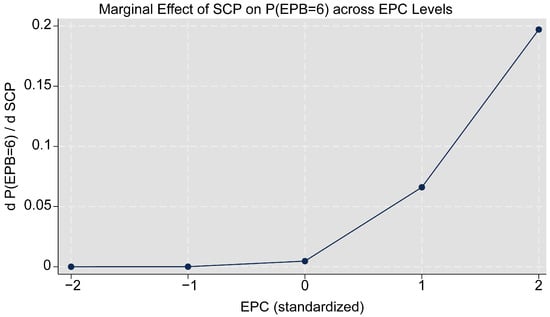
Figure A1.
Moderating effects of EPC on SCP.
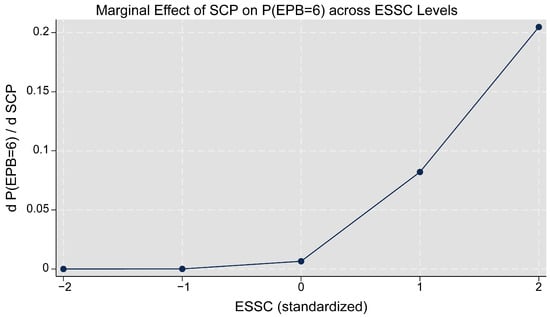
Figure A2.
Moderating effects of ESSC on SCP.
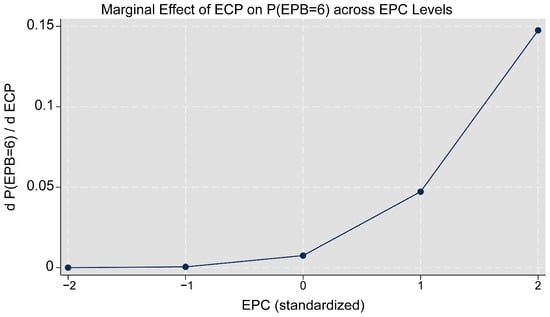
Figure A3.
Moderating effects of EPC on ECP.
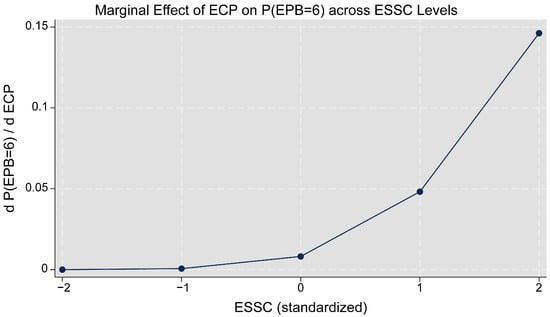
Figure A4.
Moderating effects of ESSC on ECP.
References
- Trenberth, K.E.; Dai, A.; van der Schrier, G.; Jones, P.D.; Barichivich, J.; Briffa, K.R.; Sheffield, J. Global Warming and Changes in Drought. Nat. Clim. Chang. 2014, 4, 17–22. [Google Scholar] [CrossRef]
- Hultgren, A.; Carleton, T.; Delgado, M.; Gergel, D.R.; Greenstone, M.; Houser, T.; Hsiang, S.; Jina, A.; Kopp, R.E.; Malevich, S.B.; et al. Impacts of Climate Change on Global Agriculture Accounting for Adaptation. Nature 2025, 642, 644–652. [Google Scholar] [CrossRef]
- Thompson, B.; Leduc, G.; Manevska-Tasevska, G.; Toma, L.; Hansson, H. Farmers’ Adoption of Ecological Practices: A Systematic Literature Map. J. Agric. Econ. 2024, 75, 84–107. [Google Scholar] [CrossRef]
- Akinkuolie, T.A.; Ogunbode, T.O.; Oyebamiji, V.O. Evaluating Constraints Associated with Farmers’ Adaptation Strategies to Climate Change Impact on Farming in the Tropical Environment. Heliyon 2024, 10, e36086. [Google Scholar] [CrossRef]
- McCarl, B.A. Climate Change: What Do We Do about It? Economic Issues Regarding Agricultural Adaptation and Mitigation. Am. J. Agric. Econ. 2025, 107, 368–389. [Google Scholar] [CrossRef]
- Quan, Q.; Yi, F.; Liu, H. Fertilizer Response to Climate Change: Evidence from Corn Production in China. Sci. Total Environ. 2024, 928, 172226. [Google Scholar] [CrossRef] [PubMed]
- Yi, F.; Liu, H.; Quan, Q. Impacts of Climate Change on Agricultural Chemical Inputs: Evidence from Pesticide Usage in China. Agric. Econ. 2025. [Google Scholar] [CrossRef]
- Delcour, I.; Spanoghe, P.; Uyttendaele, M. Literature Review: Impact of Climate Change on Pesticide Use. Food Res. Int. 2015, 68, 7–15. [Google Scholar] [CrossRef]
- Bareille, F.; Chakir, R.; Keles, D. Weather Shocks and Pesticide Purchases. Eur. Rev. Agric. Econ. 2024, 51, 309–353. [Google Scholar] [CrossRef]
- Xiao, O.; Li, M.; Chen, J.; Li, R.; Quan, R.; Zhang, Z.; Kong, Z.; Dai, X. Influence of Triazole Pesticides on Wine Flavor and Quality Based on Multidimensional Analysis Technology. Molecules 2020, 25, 5596. [Google Scholar] [CrossRef]
- Ma, L.; Zhu, Y.; Geng, S.; Ruan, J. Response of Nutritional Status and Tea Quality to the Rate and Substitution of Chemical Fertilizers with Organic Manure. Horticulturae 2022, 8, 1198. [Google Scholar] [CrossRef]
- Mwaka, O.; Mwamahonje, A.; Nene, W.; Rweyemamu, E.; Maseta, Z. Pesticides Use and Its Effects on Grape Production: A Review. Sustain. Environ. 2024, 10, 2366555. [Google Scholar] [CrossRef]
- Piyasena, K.G.N.P.; Hettiarachchi, L.S.K. Comparison of Tea Quality Parameters of Conventionally and Organically Grown Tea, and Effects of Fertilizer on Tea Quality: A Mini-Review. Food Chem. Adv. 2023, 3, 100399. [Google Scholar] [CrossRef]
- Turner, B.; Devisscher, T.; Chabaneix, N.; Woroniecki, S.; Messier, C.; Seddon, N. The Role of Nature-Based Solutions in Supporting Social-Ecological Resilience for Climate Change Adaptation. Annu. Rev. Environ. Resour. 2022, 47, 123–148. [Google Scholar] [CrossRef]
- Calliari, E.; Castellari, S.; Davis, M.; Linnerooth-Bayer, J.; Martin, J.; Mysiak, J.; Pastor, T.; Ramieri, E.; Scolobig, A.; Sterk, M.; et al. Building Climate Resilience through Nature-Based Solutions in Europe: A Review of Enabling Knowledge, Finance and Governance Frameworks. Clim. Risk Manag. 2022, 37, 100450. [Google Scholar] [CrossRef]
- Mi, F.; Chen, J.; Shi, J.; Li, Q. Agricultural industrial organization, retail market distance, and farmers’ ecological production behavior. China Popul. Resour. Environ. 2025, 35, 174–183. (In Chinese) [Google Scholar]
- Xi, Y.; Yang, Y.; Zhang, Q.; Zhang, Z.; Ha, Z. Research on the Influence of Ecological Specialty Industry Vine Tea on Farmers’ Livelihoods in Laifeng County, China. Front. Sustain. Food Syst. 2025, 9, 1465868. [Google Scholar] [CrossRef]
- Hernandez-Aguilera, J.N.; Conrad, J.M.; Gomez, M.I.; Rodewald, A.D. The Economics and Ecology of Shade-Grown Coffee: A Model to Incentivize Shade and Bird Conservation. Ecol. Econ. 2019, 159, 110–121. [Google Scholar] [CrossRef]
- Barnes, A.P.; Thompson, B.; Toma, L. Finding the Ecological Farmer: A Farmer Typology to Understand Ecological Practice Adoption within Europe. Curr. Res. Environ. Sustain. 2022, 4, 100125. [Google Scholar] [CrossRef]
- Xie, J.; Yang, G.; Wang, G.; Song, Y.; Yang, F. How Do Different Rural-Land-Consolidation Modes Shape Farmers’ Ecological Production Behaviors? Land Use Policy 2021, 109, 105592. [Google Scholar] [CrossRef]
- Yang, J.; Su, K.; Zhang, Z.; Guo, S.; Hou, Y.; Wen, Y. Perceived Benefit, Policy Incentive and Farmers’ Organic Fertilizer Application in Protected Areas. Agriculture 2024, 14, 810. [Google Scholar] [CrossRef]
- Brunelle, T.; Chakir, R.; Carpentier, A.; Dorin, B.; Goll, D.; Guilpart, N.; Maggi, F.; Makowski, D.; Nesme, T.; Roosen, J.; et al. Reducing Chemical Inputs in Agriculture Requires a System Change. Commun. Earth Environ. 2024, 5, 369. [Google Scholar] [CrossRef]
- Huang, Y.; Long, H.; Jiang, Y.; Feng, D.; Ma, Z.; Mumtaz, F. Motivating Factors of Farmers’ Adaptation Behaviors to Climate Change in China: A Meta-Analysis. J. Environ. Manag. 2024, 359, 121105. [Google Scholar] [CrossRef] [PubMed]
- Jijue, W.; Xiang, J.; Yi, X.; Dai, X.; Tang, C.; Liu, Y. Market Participation and Farmers’ Adoption of Green Control Techniques: Evidence from China. Agriculture 2024, 14, 1138. [Google Scholar] [CrossRef]
- Ahmed, S.; Griffin, T.S.; Kraner, D.; Schaffner, M.K.; Sharma, D.; Hazel, M.; Leitch, A.R.; Orians, C.M.; Han, W.; Stepp, J.R.; et al. Environmental Factors Variably Impact Tea Secondary Metabolites in the Context of Climate Change. Front. Plant Sci. 2019, 10, 939. [Google Scholar] [CrossRef]
- Rogers, R.W. A Protection Motivation Theory of Fear Appeals and Attitude Change1. J. Psychol. 1975, 91, 93–114. [Google Scholar] [CrossRef] [PubMed]
- Grothmann, T.; Patt, A. Adaptive Capacity and Human Cognition: The Process of Individual Adaptation to Climate Change. Glob. Environ. Chang. 2005, 15, 199–213. [Google Scholar] [CrossRef]
- Qin, X. Sample Size and Power Calculations for Causal Mediation Analysis: A Tutorial and Shiny App. Behav. Res. Methods 2024, 56, 1738–1769. [Google Scholar] [CrossRef] [PubMed]
- Sim, M.; Kim, S.-Y.; Suh, Y. Sample Size Requirements for Simple and Complex Mediation Models. Educ. Psychol. Meas. 2022, 82, 76–106. [Google Scholar] [CrossRef]
- Carpenter, S.R.; Mooney, H.A.; Agard, J.; Capistrano, D.; DeFries, R.S.; Diaz, S.; Dietz, T.; Duraiappah, A.K.; Oteng-Yeboah, A.; Pereira, H.M.; et al. Science for Managing Ecosystem Services: Beyond the Millennium Ecosystem Assessment. Proc. Natl. Acad. Sci. USA 2009, 106, 1305–1312. [Google Scholar] [CrossRef]
- Díaz, S.; Pascual, U.; Stenseke, M.; Martín-López, B.; Watson, R.T.; Molnár, Z.; Hill, R.; Chan, K.M.A.; Baste, I.A.; Brauman, K.A.; et al. Assessing Nature’s Contributions to People. Science 2018, 359, 270–272. [Google Scholar] [CrossRef]
- Sonneveld, B.G.J.S.M. Nature-Based Solutions for Agricultural Water Management and Food Security. In FAO Land and Water Discussion Papers, 1st ed.; FAO: Rome, Italy, 2018; ISBN 978-92-5-131125-7. [Google Scholar]
- Diamantopoulos, A.; Winklhofer, H.M. Index Construction with Formative Indicators: An Alternative to Scale Development. J. Mark. Res. 2001, 38, 269–277. [Google Scholar] [CrossRef]
- Nationen, V. (Ed.) Guidelines on Measurement of Well-Being; United Nations: Geneva, Switzerland, 2025; ISBN 978-92-1-157766-2. [Google Scholar]
- Li, Y.; Xu, J.; Liu, F.; Zhang, X. Impact and Mechanism of Digital Information Selection on Farmers’ Ecological Production Technology Adoption: A Study on Wheat Farmers in China. Agriculture 2024, 14, 713. [Google Scholar] [CrossRef]
- Pepin, N.C.; Arnone, E.; Gobiet, A.; Haslinger, K.; Kotlarski, S.; Notarnicola, C.; Palazzi, E.; Seibert, P.; Serafin, S.; Schoener, W.; et al. Climate Changes and Their Elevational Patterns in the Mountains of the World. Rev. Geophys. 2022, 60, e2020RG000730. [Google Scholar] [CrossRef]
- Rangwala, I.; Miller, J.R. Climate Change in Mountains: A Review of Elevation-Dependent Warming and Its Possible Causes. Clim. Change 2012, 114, 527–547. [Google Scholar] [CrossRef]
- Doherty, E.; Mellett, S.; Norton, D.; McDermott, T.K.J.; O’ Hora, D.; Ryan, M. A Discrete Choice Experiment Exploring Farmer Preferences for Insurance against Extreme Weather Events. J. Environ. Manag. 2021, 290, 112607. [Google Scholar] [CrossRef] [PubMed]
- Sun, J.-L.; Tao, R.; Wang, J.; Wang, Y.-F.; Li, J.-Y. Do Farmers Always Choose Agricultural Insurance against Climate Change Risks? Econ. Anal. Policy 2024, 81, 617–628. [Google Scholar] [CrossRef]
- Chang, Q.; Zhang, C.; Wang, L.; Jin, B.; Zhao, M. The impact of non-agricultural employment on farmers’ crop structure in the middle and upper reaches of the Yellow River. China Rural. Econ. 2021, 2021, 89–106. (In Chinese) [Google Scholar]
- Zhu, Z.; Ma, W.; Sousa-Poza, A.; Leng, C. The Effect of Internet Usage on Perceptions of Social Fairness: Evidence from Rural China. China Econ. Rev. 2020, 62, 101508. [Google Scholar] [CrossRef]
- Mobeen, M.; Kabir, K.H.; Schneider, U.A.; Ahmed, T.; Scheffran, J. Climate Change Perception, Adaptation, and Constraints in Irrigated Agriculture in Punjab and Sindh, Pakistan. Mitig. Adapt. Strateg. Glob. Chang. 2025, 30, 23. [Google Scholar] [CrossRef]
- Cano, A.; Castro Campos, B. Drivers of Farmers’ Adaptive Behavior to Climate Change: The 3F-SEC Framework. J. Rural Stud. 2024, 109, 103343. [Google Scholar] [CrossRef]
- Heider, K.; Lopez, J.M.R.; Bischoff, A.; Balbo, A.L.; Scheffran, J. Toward Climate-Resilient and Biodiverse Agriculture in the Mediterranean Region: Experiences and Perceptions of Farmers Engaged in Sustainable Food Production. Org. Agric. 2023, 13, 513–529. [Google Scholar] [CrossRef]
- Ramborun, V.; Facknath, S.; Lalljee, B. Moving toward Sustainable Agriculture through a Better Understanding of Farmer Perceptions and Attitudes to Cope with Climate Change. J. Agric. Educ. Ext. 2020, 26, 37–57. [Google Scholar] [CrossRef]
- Naazie, G.K.; Dakyaga, F.; Derbile, E.K. Agro-Ecological Intensification for Climate Change Adaptation: Tales on Soil and Water Management Practices of Smallholder Farmers in Rural Ghana. Discov. Sustain. 2023, 4, 1–15. [Google Scholar] [CrossRef]
- Kamau, E.W.; Gitau, R.; Bett, H.K. Effects of Adoption of Ecological Farming Practices on Farm Income in Rural Households: Evidence from Central Kenya. Heliyon 2024, 10, e34610. [Google Scholar] [CrossRef] [PubMed]
- Byfuglien, A.; Kvakkestad, V.; Innocenti, S. Mitigation and Adaptation in Agriculture: Effects of Framing on Farmers’ Policy Support and Sustainable Practices. Clim. Chang. 2025, 178, 64. [Google Scholar] [CrossRef]
- Ewulo, T.A.; Akinseye, F.M.; Teme, N.; Agele, S.O.; Yessoufou, N.; Kumar, S. Factors Driving Climate-Smart Agriculture Adoption: A Study of Smallholder Farmers in Koumpentum, Senegal. Front. Agron. 2025, 7, 1552720. [Google Scholar] [CrossRef]
- Purwanti, T.S.; Syafrial, S.; Huang, W.-C.; Hartono, B.; Rahman, M.S.; Putritamara, J.A. Understanding Farmers’ Adaptation to Climate Change: A Protection Motivation Theory Application. Cogent Soc. Sci. 2023, 9, 2282210. [Google Scholar] [CrossRef]
- McVittie, A.; Cole, L.; Wreford, A.; Sgobbi, A.; Yordi, B. Ecosystem-Based Solutions for Disaster Risk Reduction: Lessons from European Applications of Ecosystem-Based Adaptation Measures. Int. J. Disaster Risk Reduct. 2018, 32, 42–54. [Google Scholar] [CrossRef]
- Xu, B. Construction and production management techniques of ecological tea garden model in Wuyishan City. Fujian Tea 2022, 44, 25–27. (In Chinese) [Google Scholar] [CrossRef]
Disclaimer/Publisher’s Note: The statements, opinions and data contained in all publications are solely those of the individual author(s) and contributor(s) and not of MDPI and/or the editor(s). MDPI and/or the editor(s) disclaim responsibility for any injury to people or property resulting from any ideas, methods, instructions or products referred to in the content. |
© 2025 by the authors. Licensee MDPI, Basel, Switzerland. This article is an open access article distributed under the terms and conditions of the Creative Commons Attribution (CC BY) license (https://creativecommons.org/licenses/by/4.0/).